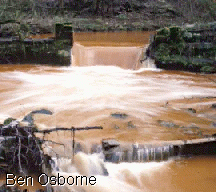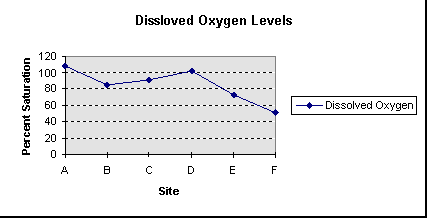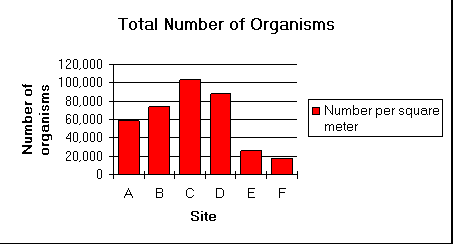Sewage
Runoff into Wheeling Creek: Let's Stop It!
By Lisa, Jason, and Chris
Students in Mr. Hathorn's Class Belarmine Preparatory School
Tacoma, Washington
Wheeling Creek is suffering
from many forms of water pollution that are affecting the water
quality. One of these major problems is sewage runoff into the river.
 There
are a couple causes of sewage runoff. One problem is during a heavy
downpour, stormwater runoff overflows the sewage treatment plant.
Due to this rain, the plant opens a system of gates that discharges
raw sewage mixed with stormwater into Wheeling Creek. Another source
of sewage runoff is from leaky septic systems of the houses surrounding
Wheeling Creek. The sewage leaks into Wheeling Creek and really
makes the water dirty. Photo: Wheeling Creek
is contaminated with sewage runoff and a number of other contaminants.
There
are a couple causes of sewage runoff. One problem is during a heavy
downpour, stormwater runoff overflows the sewage treatment plant.
Due to this rain, the plant opens a system of gates that discharges
raw sewage mixed with stormwater into Wheeling Creek. Another source
of sewage runoff is from leaky septic systems of the houses surrounding
Wheeling Creek. The sewage leaks into Wheeling Creek and really
makes the water dirty. Photo: Wheeling Creek
is contaminated with sewage runoff and a number of other contaminants.
Wheeling Creek is only
highly polluted by sewage for about five and one half miles from
site E and this flows downstream polluting the rest of the creek.

Figure 1: One way of detecting the
amount of sewage in the river is measuring the amount of dissolved
oxygen in certain parts of the river.
Different
types of bacteria tend to live and strive in the sewage that is
leaking into Wheeling Creek. This carbonaceous material decomposes
and leads to the depletion of oxygen. These bacteria use up dissolved
oxygen in the water. In the chart above, it is found that at site
E, where the sewage is coming into the creek, the amount of dissolved
oxygen decreases and keeps decreasing until site F.
Therefore,
this graph shows that from site E on, there is sewage in the river.
Located at site E is the sewage treatment plant which leaks sewage
into the river during heavy downpours.

Figure 2: Percentage of the land
that is built up around Wheeling Creek
Leaky home
septic systems have also been contributing to the sewage problem
of Wheeling Creek. As the land becomes more built up with homes,
there are more septic systems. As the number of home septic systems
increases, there tends to be a greater chance for leaky septic systems
that will add to the sewage runoff into the creek.
As seen
on figure 2, Around site E, the land is more built up than previous
sites. Generally, as the number of homes increase, the number of
septic systems will also tend to increase. This will tend to add
to the sewage problem due to the increasing number of home septic
systems.
 Figure
3: The total number of organisms at different sites in Wheeling
Creek
Figure
3: The total number of organisms at different sites in Wheeling
Creek
Another
indicator of the water quality at different sites in the creek are
the number of organisms that are able to live there. Figure 3 shows
that at site E, there is a significant decrease in the total number
of living organisms compared to previous sites.
This is
probably affected by the sewage that is being emitted into the creek
by the sewage treatment plant located there. Most organisms cannot
survive in water with sewage waste in it.


 There
are a couple causes of sewage runoff. One problem is during a heavy
downpour, stormwater runoff overflows the sewage treatment plant.
Due to this rain, the plant opens a system of gates that discharges
raw sewage mixed with stormwater into Wheeling Creek. Another source
of sewage runoff is from leaky septic systems of the houses surrounding
Wheeling Creek. The sewage leaks into Wheeling Creek and really
makes the water dirty. Photo: Wheeling Creek
is contaminated with sewage runoff and a number of other contaminants.
There
are a couple causes of sewage runoff. One problem is during a heavy
downpour, stormwater runoff overflows the sewage treatment plant.
Due to this rain, the plant opens a system of gates that discharges
raw sewage mixed with stormwater into Wheeling Creek. Another source
of sewage runoff is from leaky septic systems of the houses surrounding
Wheeling Creek. The sewage leaks into Wheeling Creek and really
makes the water dirty. Photo: Wheeling Creek
is contaminated with sewage runoff and a number of other contaminants.

 Figure
3: The total number of organisms at different sites in Wheeling
Creek
Figure
3: The total number of organisms at different sites in Wheeling
Creek